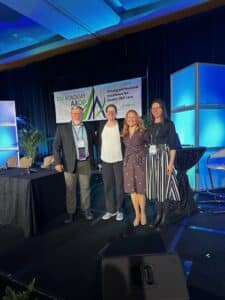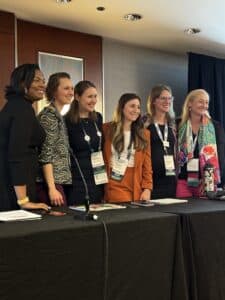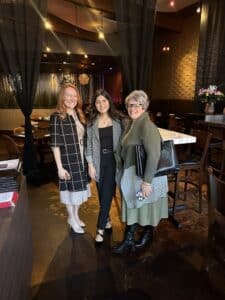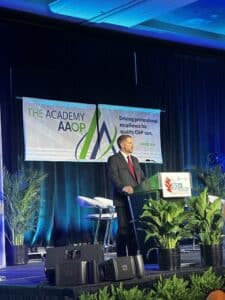By Jewel Connelly, Communications Specialist

AAOP24 Mental Health Post-Amputation Panelists Group
Flying to Chicago, I had the opportunity to attend the American Academy of Orthotists and Prosthetists (AAOP) 50th Annual Meeting and Scientific Symposium for the first time. This annual gathering of clinicians, students and residents, researchers, and O&P (Orthotics & Prosthetics) professionals was a great event, an even better chance to see and touch the latest innovative products, and an incredible learning opportunity from expert-led sessions. As Communications Specialist at the Amputee Coalition, my goal was to broaden my knowledge base around limb loss and limb difference and become more informed about the barriers which prevent people from accessing care and devices.

Photo of AAOP24, ‘Pregnancy in O&P’, Panelists Group
Each day of the annual meeting there were a variety of sessions and workshops designed to educate attendees who interact with the limb loss/limb difference community in many ways, from practicing prosthetists to O&P advocates. The first session I attended was ‘So Every BODY Can Move (SEBCM): Advocacy in Action’ which focused on the national initiative and advocates’ work at the state and federal levels. Nicole Van Kuilen (American Orthotic and Prosthetic Association, AOPA) shared her personal story as a person with lower limb loss and how it sparked her passion for making prostheses for physical activity accessible for everyone. Once 25 states pass SEBCM legislation it will be considered a majority and federal, nationwide reform can be pursued. This is why the mission to pass legislation in 28 states by the 2028 Paralympics in Los Angeles, California, an initiative named 28×28, is so crucial. When it comes to advocacy, Nicole encouraged attendees to “start before you’re ready,” and finished by sharing her heartfelt testimony in Minnesota only the day before, where the bill passed unanimously.
‘The Road to Running’ was a session specifically geared towards prosthetists who are fabricating running-specific prostheses. As more patients can receive these specialized devices because of legislative efforts, it’s important clinicians are prepared to accommodate the increase in demand. I learned that C-shaped running blades are ideal for recreational runners while J-shaped prostheses are used by sprinters. Other considerations included prosthesis prescription decision-making and alignment principles. Videos were shown so attendees could compare a runner wearing a prosthesis that was too tall or short to one which fit correctly as visual demonstrations.
On Friday, I learned more about factors which affect O&P in both the political sphere and healthcare. In the ‘Future Political Climate in O&P’ session the speaker, Mac McClellan (CPO/L, FISPO, FAAOP(D)), discussed what policy changes can be anticipated in the upcoming year. So Every BODY Can Move is a widespread initiative, and it was found that it would only cost a $0.39 increase in insurance premiums to enact this legislation. States like Minnesota are emphasizing the long-term cost savings for insurance companies who enact SEBCM due to reduction in comorbidities. Some state bills also include shower legs because they are just as important to activities of daily living. One session on ‘Correct Coding for Upper Limb Prosthesis’ was particularly interesting to learn more about how HCPCS codes dictate access to care. My friend and Baylor College resident in attendance also explained to me that insurance reimburses the same amount for simple and bionic devices and that the same codes are used for both. This in turn prevents many prosthetists from being able to offer their patients the best devices simply because of financial reasons.

Photo of Ashlie, Shree, and Cass at AAOP24
Between the robust schedule of offerings, there were also plenty of more informal learning opportunities just exploring the Exhibit Hall. With more than 100 manufacturers, this was the event’s largest exhibit hall in the Academy’s history. Meeting Dr. Aadeel Akhtar, founder and CEO of PSYONIC, I visited his company’s booth in the exhibit hall and participated in the Ability Hand demo. Moving my hand and fingers, the movements were communicated through motion capture which enabled me to manipulate the bionic hand. Walking around the exhibit hall, I also had conversations with Ossur and Proteor to learn more about their prosthetic devices on display. One of the reps at the Proteor booth had tested out the SYNSYS microprocessor full-leg system and explained all the features of the new device. This leg has triple flexion with an ankle that allows for different shoe heights. However, the biggest barrier remains insurance coverage which prevents many from being able to take advantage of this technology.
The conversation around medical necessity is of significant importance to accessibility and ‘Medical Necessity in Prosthetics and Orthotics’ on the final day helped to understand it from a physician perspective. The patient must have an unmet need which requires a solution. Based on this, a device is considered “medically necessary” if it meets the patient’s needs better than other available options. The same medical information, depending on how it is presented, can either support or oppose medical necessity-based reasoning which can be very black and white. I learned physicians play a role in building the case for medical necessity vs functional desires like returning to a previous hobby.

Photo of Mark Holowka, MSPO, CPO, FAAOP(D) President, AAOP Children’s Healthcare of Atlanta, Georgia
One session I was unable to attend, but heard the room was packed with many attendees seated on the floor and standing along the walls was on ‘Pregnancy in O&P.’ Shree Thaker, Director of Communications & Partnerships, shared her experience from what she claimed was the most moving and impactful session of the conference. There were three primary takeaways: 1. pregnant clinicians should ask for and receive reasonable accommodations; 2. pregnant people who have limb loss and limb difference who are being treated by O&P and other healthcare professionals should have their changing bodies taken into consideration for scheduling appointments, socket fit, at-home adjustments, etc, and; 3. for pediatric patients who have limb loss and/or limb difference being treated by O&P and other healthcare professionals, who have parents who are pregnant, clinics should coordinate approved guardians who can bring the youth minors for appointments without the pregnant parent and consider advanced scheduling of follow-up appointments. The trend shift in allied healthcare (O&P, physical and occupational therapy, etc) of higher numbers of female clinicians in the past two decades began fostering an environment that only recently has started including support services and considerations for pregnancy, even though weight, swelling and edema, and hormonal changes are all known complication factors for prosthetic and orthotic fit and comfort. The panelists were given a standing ovation for sharing their vulnerable stories amongst the session attendees which roughly was a 75:25 split female:male. The room was filled with optimism for tangible actions that can improve the quality of O&P care that is both provided and received in regard to pregnancy.
Finally, the last presentation I attended, ‘Mental Health Post Amputation’ focused on the psychological reactions following amputation and how clinicians can help their patients experiencing mental health struggles. Ashlie White, Chief Strategy & Programs Officer, was one of the speakers and discussed the National Limb Loss Resource Center, Community Connections, and feedback the Amputee Coalition’s Support Services department is hearing from the community. The experience of limb loss is multifaceted and restoring mobility is only one piece of addressing quality of life.
After three days there, the AAOP Annual Meeting helped me gain a greater understanding of the realities of what people who have limb loss and limb difference need to live full lives and the hurdles many encounter. I even had the opportunity to take part in a research study conducted onsite by the Shirley Ryan AbilityLab. Evaluating my gait as an able-bodied person, the researcher asked me to walk different predetermined routes at different speeds while my movements were recorded through motion capture. I also had to do a few patterns and turns, moving from a seated to a standing position. Attending conferences like these is beneficial to continue asking the right questions as an organization and advocating for the policies that matter most to the community.

